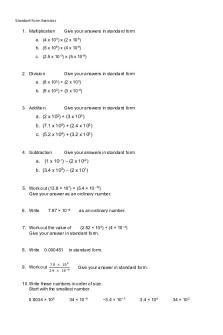Selected week 3 carbohydrates questions PDF

| Title | Selected week 3 carbohydrates questions |
|---|---|
| Course | Human Nutrition |
| Institution | Edith Cowan University |
| Pages | 3 |
| File Size | 69.8 KB |
| File Type | |
| Total Downloads | 13 |
| Total Views | 152 |
Summary
Lecturer- Stephanie Godrich...
Description
Topic 3: Selected questions 1. In which of the following are ample amounts of carbohydrates almost always found? a. Plant foods b. Health foods c. Animal products d. Protein-rich foods ANS: 2. All of the following are sources of dietary carbohydrates, except: a. fish. b. milk. c. fruits. d. legumes. ANS: 3. The differing sequences of atoms accounts for which difference between monosaccharides? a. Sweetness b. Stability c. Physical appearance d. Function ANS: 4. How many carbon atoms are found in most common dietary monosaccharides? a. Five b. Six c. Eight d. 12 ANS: 5. The types of atoms found in a glucose molecule include all of the following, except: a. carbon. b. oxygen. c. nitrogen. d. hydrogen. ANS: 6. The monosaccharide glucose also known as: a. Blood sugar b. Honey c. Sucrose d. Milk sugar ANS: 7. All of the following are typical dietary sources of carbohydrate, except: a. starch. b. maltose. c. glycogen. d. hemicellulose. ANS: 8. Which of the following is known as fruit sugar or levulose? a. Maltose b. Glucose c. Fructose d. Galactose ANS:
9. Which of the following is not a characteristic of glucose? a. It is soluble in water b. It is a monosaccharide c. It is part of the sucrose molecule d. It is sweeter-tasting than sucrose ANS: 10. What is the name for the reaction that links two monosaccharides together? a. Hydrolysis b. Absorption c. Disaccharide d. Condensation ANS: 11. Which of the following is a byproduct of the condensation of two molecules of glucose? a. Water b. Oxygen c. Hydrogen d. Carbon dioxide ANS: 12. What is the composition of lactose? a. Two fructose units b. One glucose unit and one fructose unit c. One glucose unit and one galactose unit d. One galactose unit and one fructose unit ANS: 13. The chemical reaction by which starch is split into monosaccharides is termed: a. hydrolysis. b. condensation. c. gluconeogenesis. d. homeostatic balancing. ANS: 14. The joining of glucose and fructose forms which disaccharide? a. Sucrose b. Lactose c. Starch d. Maltose ANS: 15. Which of the following foods is the principal source of lactose? a. Milk b. Table sugar c. Fruit d. Starchy foods ANS: 16. What is the name of the animal polysaccharide that is composed of glucose units? a. Fibre b. Enzyme c. Dextrin d. Glycogen ANS: 17. Glycogen is mainly stored in which of the following tissues?
a. Muscle and liver b. Pancreas and kidneys c. Stomach and intestine d. Brain and red blood cells ANS: 18. What is the primary storage form of carbohydrate in the body? a. Fibre b. Starch c. Glucose d. Glycogen ANS: 19. Which of the following is not a rich source of dietary starch? a. Grains b. Fruits c. Tubers d. Legumes ANS: 20. Which of the following is not a fibre? a. Cellulose b. Pectin c. Glycogen d. Lignin ANS: 21. Which of the following is not a characteristic of soluble fibre? a. It dissolves in water. b. It forms a gel. c. It promotes bowel movements. d. It is easily digested in the colon. ANS: 22. A fibre that is extracted from plants and has a beneficial health effect is known as: a. wholegrain. b. high-fibre. c. a functional food. d. a polysaccharide. ANS: 23. Where in the body is fibre fermented and digested? a. Mouth b. Stomach c. Small intestine d. Large intestine ANS:...
Similar Free PDFs

Lecture 3 - Carbohydrates
- 8 Pages

Week 3 Differentiation Questions
- 2 Pages

Week 3 Homework Questions
- 3 Pages

Week 3 - vectors Questions
- 1 Pages

Tutorial Questions week 3
- 2 Pages

Week 3 questions. and answers
- 3 Pages

Tutorial 2 - Week 3 Questions
- 1 Pages

Standard Form Questions - Week 3
- 4 Pages

Week 3 Lab Review Questions
- 3 Pages

Carbohydrates worksheet
- 2 Pages

E11 Carbohydrates
- 2 Pages

Carbohydrates 1
- 7 Pages

In Week 3 - Week 3
- 1 Pages
Popular Institutions
- Tinajero National High School - Annex
- Politeknik Caltex Riau
- Yokohama City University
- SGT University
- University of Al-Qadisiyah
- Divine Word College of Vigan
- Techniek College Rotterdam
- Universidade de Santiago
- Universiti Teknologi MARA Cawangan Johor Kampus Pasir Gudang
- Poltekkes Kemenkes Yogyakarta
- Baguio City National High School
- Colegio san marcos
- preparatoria uno
- Centro de Bachillerato Tecnológico Industrial y de Servicios No. 107
- Dalian Maritime University
- Quang Trung Secondary School
- Colegio Tecnológico en Informática
- Corporación Regional de Educación Superior
- Grupo CEDVA
- Dar Al Uloom University
- Centro de Estudios Preuniversitarios de la Universidad Nacional de Ingeniería
- 上智大学
- Aakash International School, Nuna Majara
- San Felipe Neri Catholic School
- Kang Chiao International School - New Taipei City
- Misamis Occidental National High School
- Institución Educativa Escuela Normal Juan Ladrilleros
- Kolehiyo ng Pantukan
- Batanes State College
- Instituto Continental
- Sekolah Menengah Kejuruan Kesehatan Kaltara (Tarakan)
- Colegio de La Inmaculada Concepcion - Cebu


